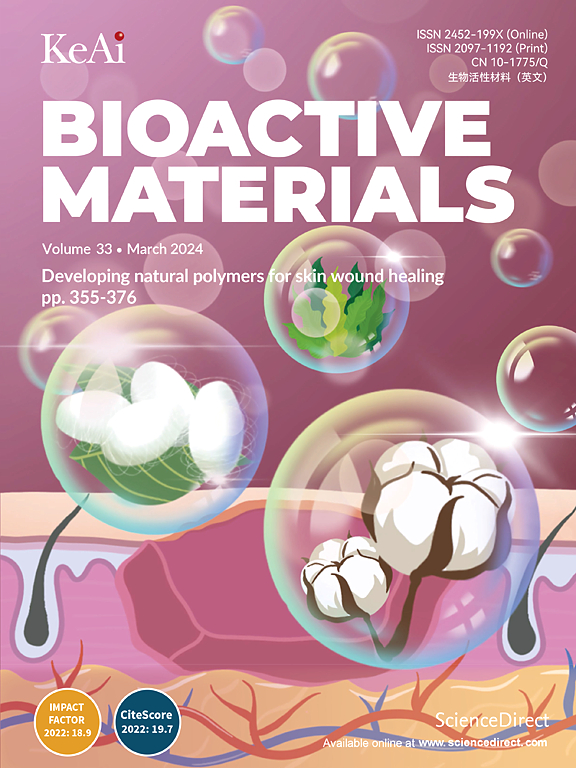In situ UNIversal Orthogonal Network (UNION) bioink deposition for direct delivery of corneal stromal stem cells to corneal wounds
IF 18
1区 医学
Q1 ENGINEERING, BIOMEDICAL
引用次数: 0
Abstract
The scarcity of human donor corneal graft tissue worldwide available for corneal transplantation necessitates the development of alternative therapeutic strategies for treating patients with corneal blindness. Corneal stromal stem cells (CSSCs) have the potential to address this global shortage by allowing a single donor cornea to treat multiple patients. To directly deliver CSSCs to corneal defects within an engineered biomatrix, we developed a UNIversal Orthogonal Network (UNION) collagen bioink that crosslinks in situ with a bioorthogonal, covalent chemistry. This cell-gel therapy is optically transparent, stable against contraction forces exerted by CSSCs, and permissive to the efficient growth of corneal epithelial cells. Furthermore, CSSCs remain viable within the UNION collagen gel precursor solution under standard storage and transportation conditions. This approach promoted corneal transparency and re-epithelialization in a rabbit anterior lamellar keratoplasty model, indicating that the UNION collagen bioink serves effectively as an in situ-forming, suture-free therapy for delivering CSSCs to corneal wounds.

原位通用正交网络(UNION)生物链接沉积用于直接递送角膜基质干细胞到角膜创面
世界范围内可用于角膜移植的人类供体角膜移植组织的稀缺性要求开发治疗角膜失明患者的替代治疗策略。角膜基质干细胞(cscs)通过允许单个供体角膜治疗多个患者,有可能解决这一全球短缺问题。为了将cscs直接输送到工程生物基质中的角膜缺陷中,我们开发了一种通用正交网络(UNION)胶原生物连接,该生物连接通过生物正交共价化学原位交联。这种细胞凝胶疗法具有光学透明、抗csc施加的收缩力稳定、允许角膜上皮细胞有效生长的特点。此外,在标准的储存和运输条件下,CSSCs在UNION胶原凝胶前体溶液中保持活力。该方法在兔前板层角膜移植术模型中促进了角膜透明度和再上皮化,表明UNION胶原生物连接可以有效地作为一种原位形成、无缝线的治疗方法,将cscs输送到角膜创面。
本文章由计算机程序翻译,如有差异,请以英文原文为准。
求助全文
约1分钟内获得全文
求助全文
来源期刊

Bioactive Materials
Biochemistry, Genetics and Molecular Biology-Biotechnology
CiteScore
28.00
自引率
6.30%
发文量
436
审稿时长
20 days
期刊介绍:
Bioactive Materials is a peer-reviewed research publication that focuses on advancements in bioactive materials. The journal accepts research papers, reviews, and rapid communications in the field of next-generation biomaterials that interact with cells, tissues, and organs in various living organisms.
The primary goal of Bioactive Materials is to promote the science and engineering of biomaterials that exhibit adaptiveness to the biological environment. These materials are specifically designed to stimulate or direct appropriate cell and tissue responses or regulate interactions with microorganisms.
The journal covers a wide range of bioactive materials, including those that are engineered or designed in terms of their physical form (e.g. particulate, fiber), topology (e.g. porosity, surface roughness), or dimensions (ranging from macro to nano-scales). Contributions are sought from the following categories of bioactive materials:
Bioactive metals and alloys
Bioactive inorganics: ceramics, glasses, and carbon-based materials
Bioactive polymers and gels
Bioactive materials derived from natural sources
Bioactive composites
These materials find applications in human and veterinary medicine, such as implants, tissue engineering scaffolds, cell/drug/gene carriers, as well as imaging and sensing devices.
 求助内容:
求助内容: 应助结果提醒方式:
应助结果提醒方式:


